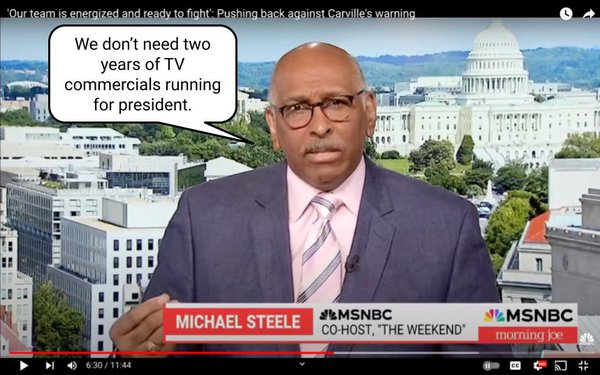
One of the biggest consequences of Kamala Harris'
rapid-fire presidential campaign ascent isn't how it will impact voters -- blue, red or otherwise -- but the implications it holds for the making of future presidents. You know, the advertising and
media parts.
It's something I've been thinking about for some time leading up to Harris' endorsement to replace President Joe Biden as the Democratic party's nominee, just a hundred days
before the election, but it was articulated in comments Michael Steele made on MSNBC's "Morning Joe" this morning that should send shivers up the spines of every political media consultant, agency, as
well as their media supply chain -- especially local TV stations:
"Joe Biden may have unlocked for us, a very important key in our electoral process, because what we are seeing now is the
reason why we don’t need two years of a presidential race," Steele quipped, adding, "Sorry consultants – I know, I know – but we can do this in a very short timeframe, because Kamala
Harris is doing it."
advertisement
advertisement
While Steele didn't venture what the time frame of the new political media campaign cycle should be, he pronounced the two-year lead-up effectively dead, noting "you can
do it in six to eight months."
"I’m not saying it’s something the next cycle we are going to do this in six months, but it shows that it can be done," he concluded, adding, "We
don’t need two years of TV commercials running for president."
That vacuous sound you hear is the gaping open mouths of political media consultants worldwide -- not just for presidential
elections, but up and down the ballots too, because if Steele's premise holds true, it's something that could impact all forms of political races.
While Steele attributed his new "snap," or
agile political campaign cycle to the Kamala Harris use case, it's something I've been thinking about increasingly for years.
In fact, I've been using my own similar thesis to provide
reassurance to friends and family during some recent campaign news cycle low points.
It goes something like this: "Don't worry what so-and-so's performance was like, or what the polls are
showing, because there will be so many volatile shifts in the campaign news cycle that no one will know anything until just before Election Day on Nov. 5."
It wasn't just reassurance. I
actually believe that.
I started formulating this perspective exactly four years ago, when near the tail end of Donald Trump's presidency, the political tracking team at Ipsos released a
unique analysis showing the political news cycle had already compressed to
daily under the Trump administration.
In the 48 monthly briefings Ipsos' poltical tracking team has held since then, I've asked if they could update their political news cycle analysis
again. I did so again during this week's briefing, and they promise to, but even without their scientific analytics, I can tell you it still is shifting roughly daily and at some points, intraday.
In fact, another Ipsos analysis released late last year, described an even more volatile addition
to the political news cycle -- one it dubbed the "polycrisis" in which multiple, earth-shattering news events collide, making campaign outcomes even less predictable.
This is the reason I
believe statistical polling has lost its efficacy as political campaign indicator in recent years. Not respondent bias, just the fact that the underlying truth shifts so rapidly during campaign cycles
that there is too much of a lag effect for the probability of political polls to be predictive or accurate. I mean, what good does it do you to assess what people think and feel based on yesterday's
news. Or maybe even this morning's news.
Honestly, I think the same thing is true of prediction markets data, which in recent years has been celebrated as a more accurate predictor of campaign
outcomes. I respect the science, and contributor Ed DeNicola has published a
number of op-eds analyzing them and citing the foundational research of prediction analytics expert Allan Lichtman's "13 keys" for predicting a presidential election.
While I think the science
is valid and should be considered, I think the 2024 campaign has so many unprecedented variables -- a former president challenging an incumbent president, an assassination attempt, an incumbent
stepping down and anointing his vice president a hundred days out, etc., etc., etc. -- that I don't think it can be modeled.
By the way, I'm willing to make a prediction of my own: There will
be many, many more prediction keys breakers in the weeks and days ahead.
I can't tell you what all of them will be, because they will be based on organic shifts in the news cycle, but some are
already calendarized:
- A Democratic National Convention -- and its nomination process -- unlike any other.
- Trump's felony conviction sentencing immediately after
that.
- A presumptive second televised presidential debate (assuming it's not behind bars).
And these are the relatively knowns. I have
to tell you that for months I've been receiving multiple dispatches from gambling odds sites highlighting even wackier bets on all sorts of presidential campaign development scenarios, and the more
this campaign drags on, the less outlandish I think many of them are.
So fasten your seatbelts, and enjoy -- or feel free to hurl -- during the rest of this rollercoaster ride. But the bottom
line for the $10 billion-plus U.S. political advertising marketplace is that MSNBC's Michael Steel is absolutely right. There is no need to spend billions of dollars for two years leading up to the
election to have an impact on it.
And while Steele didn't say exactly what the new advertising cycle should be, my recommendation is to keep your powder dry until you absolutely have to fire
something.